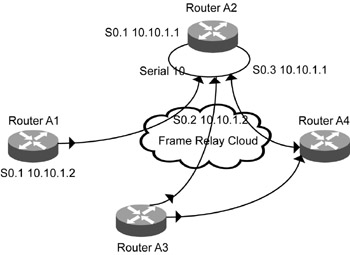NBMA Networks
This section discusses troubleshooting the problems in NBMA networks in OSPF.
Consider the example depicted in Figure 9.5. In the figure, a Frame Relay NBMA cloud is shown between routers A1, A2, A3, and A4. All the routers are not connected with each other via physical links.

Figure 9.5: A Frame Relay NBMA network in OSPF.
OSPF considers an NBMA cloud to be similar to a broadcast based network. However, the exchange of Hello packets and DR and BDR elections will not take place due to lack of any-to-any physical connectivity. This problem can be solved using any of these two methods:
-
Configure subinterfaces as point-to-point links in the NBMA cloud.
-
Define the OSPF network with point-to-multipoint links in the NBMA cloud.
Configure Interface as Point-to-Point Links
In this approach to solving the adjacency formation problem in an NBMA network, the subinterfaces are configured as point-to-point links in the NBMA cloud. This method solves the problem of election of DR and BDR, and adjacencies are formed. The configuration of A2 is shown in Listing 9.17.
Listing 9.17 Configuration of A2
interface Serial 0 no ip address encapsulation frame-relay ! interface Serial0.1 point-to-point ip address 10.10.1.1 255.255.255.252 frame-relay interface-dlci 10 ! interface Serial0.2 point-to-point ip address 10.10.2.1 255.255.255.252 frame-relay interface-dlci 15 ! interface Serial0.3 point-to-point ip address 10.10.3.1 255.255.255.252 frame-relay interface-dlci 20 !
The configuration of A1 is shown in Listing 9.18.
Listing 9.18 Configuration of A1
interface Serial 0 no ip address encapsulation frame-relay ! interface Serial0.1 point-to-point ip address 10.10.1.2 255.255.255.252 frame-relay interface-dlci 25 !
Service providers normally allocate the same subnet to all the interfaces that are part of the NBMA cloud. In the use of subinterfaces, the adjacency issue is solved, but allotting of different subnets corresponding to the subinterfaces is performed with the use of IP unnumbered on the links. However, this method is not acceptable for many network administrators as it hinders uniformity.
Define OSPF Network as Point-to-Multipoint Links
In this approach to solve the adjacency formation problem in the NBMA network, the OSPF network is defined as point-to-multipoint. The configuration of A2 is shown in Listing 9.19.
Listing 9.19 Configuration of A2
! interface Serial 0 ip address 10.10.1.1 255.255.255.0 encapsulation frame-relay ip ospf network point-to-multipoint !
The configuration of A1 is shown in Listing 9.20.
Listing 9.20 Configuration of A1
! interface Serial 0 ip address 10.10.1.2 255.255.255.0 encapsulation frame-relay ip ospf network point-to-multipoint !
In this approach, the single subnet is used for all members of the NBMA cloud. There is no issue for physical connectivity between all the routers for DR and BDR elections. Some additional information parameters are exchanged in link state updates to help in establishing connectivity with neighboring routers.
EAN: 2147483647
Pages: 130
- Integration Strategies and Tactics for Information Technology Governance
- A View on Knowledge Management: Utilizing a Balanced Scorecard Methodology for Analyzing Knowledge Metrics
- Technical Issues Related to IT Governance Tactics: Product Metrics, Measurements and Process Control
- Governance in IT Outsourcing Partnerships
- Governance Structures for IT in the Health Care Industry